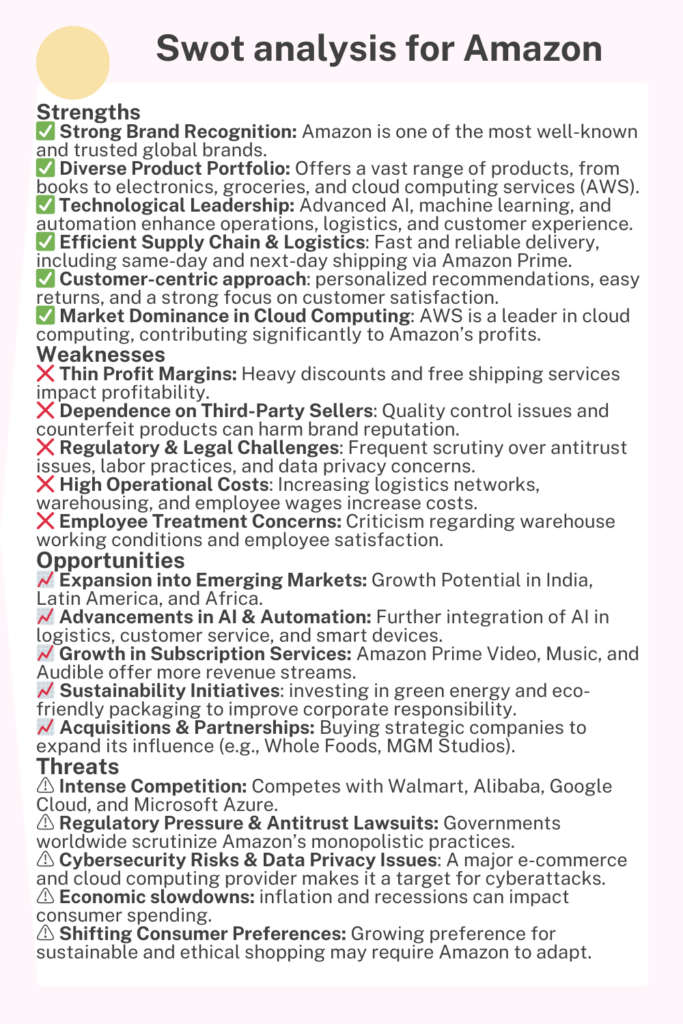Swot Analysis for Amazon
Let’s examine the amazon swot analysis, a prominent American multinational technology company based in Seattle. With a focus on e-commerce, cloud computing, digital streaming, and artificial intelligence, Amazon operates the world’s largest e-commerce platform and provides widely used cloud computing services.
Its target markets include online buyers and sellers, cost-conscious data storage seekers, entertainment enthusiasts, and customers interested in various artificial intelligence products. In its various business domains, Amazon faces competition from eBay, AliExpress, Wish, Taobao, and Craigslist.
Amazon SWOT Analysis
SWOT (Strength, Weakness, Opportunity, Threat)

STRENGTH
Strong brand name support: As a global e-commerce giant, Amazon has a strong position and successful brand image.
· Brand valuation
Support: According to Interbrand’s Global Brand Ranking 2019, Amazon is ranked at #3 (after Apple at #1 and Google at #2), with a brand value of $125 Billion.
Support: Amazon caters to many customers for everyday needs at inexpensive prices. This has made it a customer-oriented brand.
-
Differentiation and Innovation
Support: Amazon frequently brings creative ideas and innovative additions to its product line and service offerings, such as ambitious drone delivery service and Withing Aura Smart Sleep System. This creates differentiation from other companies.
Support: According to Business Strategy Hub, Amazon doesn’t incur costs in maintaining physical retail stores by selling everything online. With economies of scale, Amazon efficiently controls costs and lowers inventory replenishment time.
The company has formed numerous strategic alliances with companies like Evi Technologies, Thalmic Labs, Shoefitr, The Orange Chef, etc. It has a strong value chain system that helps maintain a low-cost structure.
-
Largest Merchandise Selection
Support: According to Business Strategy Hub, Amazon owns an extensive product mix that attracts online customers to make their majority of purchases from it rather than other online retailers. As of 2018. Amazon has sold 562.3 million products in its Amazon.com Marketplace.
- A large number of third-party sellers
Support: Due to the high volume of traffic on Amazon’s sites, many third-party sellers have joined Amazon’s Amazon platform to sell their merchandise. The data from Fulfillment by Amazon (FBA) reveals that more than 2 billion items are available from third-party sellers.
-
Go Global and Act Local Strategy
Support: According to Business Strategy Hub, this strategy has benefited Amazon the most. Amazon develops partnerships with local supply chain companies that help it compete against domestic e-commerce rivals. It understands the local needs and launches its services per the country’s culture.
-
A large number of acquisitions
Support: The successful acquisitions of Whole Foods, Zappos.com, woot.com, Junglee.com, IMBD.com, and many others have produced significant revenues and profits for Amazon.
-
Extensive Product Range and Market Dominance
Amazon offers many products, including books, electronics, household items, and groceries. Its diverse marketplace and global reach have established Amazon as a leader in the e-commerce industry.
-
Strong Brand Recognition and Customer Loyalty
Amazon has built a strong brand that is recognized worldwide. Its commitment to excellent customer service, fast delivery, and hassle-free returns has earned the trust and loyalty of millions of customers.
Amazon is known for its continuous investment in technology and innovation. The company has developed cutting-edge technologies such as voice-controlled smart speakers (Amazon Echo) and artificial intelligence (AI) algorithms that power personalized recommendations.
-
Efficient Logistics and Fulfillment Network
Amazon has built an extensive logistics network, enabling fast and reliable deliveries. Its sophisticated fulfillment centers, strategically located across the globe, ensure efficient order processing and shipment.
WEAKNESS
-
Dependence on Online Sales
While Amazon’s dominance in the online marketplace is a strength, it also creates a vulnerability. The company relies heavily on online sales, making it susceptible to disruptions in internet connectivity or cybersecurity threats.
-
Counterfeit and Imitation Products
As a vast online marketplace, Amazon faces challenges in controlling the quality and authenticity of third-party seller products. Counterfeit and imitation goods can undermine customer trust and tarnish the brand’s reputation.
-
Labor and Employment Issues
Amazon has faced criticism regarding its treatment of workers. Reports of harsh working conditions and inadequate wages have raised concerns about labor practices within the company.
-
Reliance on Third-Party Sellers
While third-party sellers contribute to Amazon’s extensive product range, the company’s reliance on them poses risks. Negative customer experiences with third-party sellers could reflect poorly on Amazon’s brand image.
· An easily imitable business model
Support: Online retail businesses have become quite common in this digital world. So, imitating Amazon’s business model for rival firms is not difficult.
A few businesses are even giving Amazon a tough time. These include Barnes & Noble, eBay, Netflix, Hulu, Oyster, etc.
-
Losing Margins in a Few Areas
Support: Amazon has faced losses in a few areas, such as India. It’s free shipping to customers can be one reason that exposes the risks of losing margins in some markets.
-
Product Flops and Failures
Support: According to The Street, Amazon has had to try to make other products other than AWS and Amazon.com. However, many have ended up as a failure. Such as the Amazon Fire Phone, which started on sale in July 2014. However, Amazon soon removed the phone from its shelves in September 2015 because of a big loss of profit.
-
Tax Avoidance Controversy
Support: According to Business Strategy Hub, Tax avoidance in Japan, the UK, and the US have sparked negative publicity for Amazon. President Trump has recently criticized Amazon over taxes on social media networks.
-
Limited brick-and-mortar presence
Support: Amazon owns very limited physical stores. This sometimes hinders attracting customers to buy things that are not sellable in online stores.
-
Limited penetration in developing markets
Support: Amazon took a big part of the e-commerce market in America. But Amazon didn’t take a big part in the world. there are many e-commerce companies like Alibaba, eBay, wish, and others to compete with Amazon. There are markets that Amazon is hard to squeeze into, such as China, Europe, and India.
Support: although many products that sell on Amazon are regulated and high-quality. But, since Amazon allows all third-party seller to sell their products on Amazon, Amazon can’t determine whether the product is genuine or counterfeit.
-
Seasonality of the business
Support: Amazon has a high seasonality business revenue. According to Amazon.com Inc.’s annual report, the company generated 32%, 34%, and 31% of our yearly revenue during the fourth quarter of 2016, 2017, and 2018, respectively.
Check this CIPD Assignment Help
OPPORTUNITY
- Expansion in developing markets
Support: Many online sites talk about future trends in e-commerce. According to Beeketing, one trend is global e-commerce retail sales will hit 4.9 trillion in 2021. This is a 256% growth rate from 2014 to 2021. Another trend is that the center of eCommerce is shifting from the western hemisphere.
Even though Amazon is harder to squeeze into China’s e-commerce market. but it can take advantage of other Asian countries’ e-commerce markets. Other trends, such as e-commerce personalization, will be a standard. The mobile shopping revolution and voice commerce are on the horizon, and these are all opportunities for Amazon. Because Amazon has already
-
Expansion into New Markets
Amazon has the opportunity to expand its presence in untapped markets worldwide. By adapting its business model to cater to local needs and preferences, Amazon can establish itself as a dominant player in emerging economies.
-
Continued Growth of E-commerce
The global e-commerce market is expected to continue growing rapidly. Amazon can leverage this trend by enhancing its e-commerce infrastructure, improving customer experience, and expanding its range of services.
-
Cloud Computing and Web Services
Amazon Web Services (AWS) is a leading provider of cloud computing solutions. The increasing demand for cloud services presents an opportunity for Amazon further to expand its market share in this lucrative sector.
-
Acquisition and Diversification
Amazon has a history of successful acquisitions, such as Whole Foods Market. The company can explore further strategic acquisitions to diversify its offerings and enter new industries.

Threats
Amazon faces fierce competition from both established players and emerging e-commerce platforms. Competitors such as Walmart, Alibaba, and eBay threaten Amazon’s market share and profitability.
As a global company operating in various countries, Amazon is subject to diverse regulatory frameworks. Changes in regulations related to taxes, data privacy, and antitrust can impact the company’s operations and profitability.
Disruptions in the global supply chain, such as natural disasters or political instability, can affect Amazon’s ability to deliver products on time and meet customer expectations.
-
Changing Consumer Preferences
Consumer preferences and shopping behaviors evolve. Amazon must stay attuned to these changes and adapt its offerings and services accordingly to retain its customer base.
Threats to Amazon
Amazon faces fierce competition from both established players and emerging e-commerce platforms. Competitors such as Walmart, Alibaba, and eBay threaten Amazon’s market share and profitability.
As a global company operating in various countries, Amazon is subject to diverse regulatory frameworks. Changes in regulations related to taxes, data privacy, and antitrust can impact the company’s operations and profitability.
Disruptions in the global supply chain, such as natural disasters or political instability, can affect Amazon’s ability to deliver products on time and meet customer expectations.
-
Changing Consumer Preferences
Consumer preferences and shopping behaviors evolve. Amazon must stay attuned to these changes and adapt its offerings and services accordingly to retain its customer base.
Conclusion
Amazon’s SWOT analysis reveals a company with significant strengths, opportunities, weaknesses, and threats. The company’s extensive product range, strong brand recognition, and technological innovation position it well for continued success.
However, labor issues, counterfeit products, and intense competition require ongoing attention. By leveraging its strengths, capitalizing on opportunities, and addressing weaknesses and threats, Amazon can maintain its position as a global e-commerce leader.
FAQs
Q1: How did Amazon become so successful?
Amazon’s success can be attributed to several factors, including its extensive product range, strong customer service, technological innovation, and efficient logistics network. The company’s relentless focus on customer satisfaction and continuous investment in improving its offerings have contributed to its success.
Q2: Does Amazon only sell books?
No, Amazon started as an online bookstore but has expanded its offerings significantly. Today, Amazon sells various products, including electronics, fashion, home goods, groceries, and digital services like streaming music and video.
Q3: What are some of the challenges Amazon faces?
Amazon faces challenges such as counterfeit products, labor and employment issues, intense competition, and regulatory complexities. These challenges require the company to adapt and evolve to maintain its competitive edge.
Q4: Can Amazon sustain its dominance in the e-commerce market?
While Amazon holds a strong position in the e-commerce market, the industry is dynamic and highly competitive. Sustaining dominance will require Amazon to continue innovating, improving customer experience, and expanding into new markets and industries.
Q5: What are some potential growth areas for Amazon?
Amazon has opportunities for growth in expanding into new markets, such as emerging economies, and diversifying its offerings through strategic acquisitions. Additionally, cloud computing and web services development presents a significant opportunity for the company through its Amazon Web Services (AWS) division.










